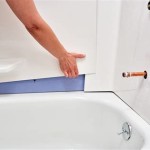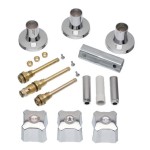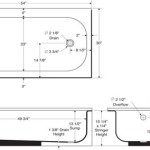What Are The Parts Of A Bathtub Called?
A bathtub, a seemingly simple fixture found in most homes, is comprised of various components, each serving a distinct purpose to ensure proper functioning and user comfort. Understanding the names and functions of these individual parts is essential for maintenance, repair, and even when planning a bathroom renovation. This article will provide a comprehensive overview of the key components of a standard bathtub, covering both visible and less conspicuous elements.
The anatomy of a bathtub can be divided into several categories: the main structure, the drain and overflow system, the faucet and water delivery system, and any additional features. Each category contains specific parts that work in conjunction with one another to create a functional and enjoyable bathing experience. Addressing each of these components in detail will provide a thorough understanding of the overall structure.
The Bathtub Shell and Support Structure
The primary shell of the bathtub constitutes the largest and most visually prominent component. This is the basin into which water is filled for bathing. The shell is typically constructed from materials such as acrylic, fiberglass, cast iron, or steel, each offering varying levels of durability, heat retention, and cost.
The shape and size of the bathtub shell can vary significantly depending on the style. Common shapes include rectangular, oval, corner, and freestanding designs. The interior surface is usually smooth and sloped for comfortable reclining. The exterior may be plain or feature decorative elements depending on the overall design aesthetic. The shell’s integrity is crucial for retaining water and preventing leaks.
Beneath the visible shell lies the support structure. This structure is critical for ensuring the bathtub remains stable and can withstand the weight of water and bathers. The support structure often consists of a frame or leveling feet. In some cases, the bathtub is embedded into a surround or platform that provides additional support. The frame, often crafted from wood or metal, distributes the weight evenly across the floor. Leveling feet allow for adjustments to be made to ensure the bathtub sits perfectly level, which is crucial for proper drainage.
The apron is another visible part of the bathtub, often integral to its structural support. The apron is the finished panel that encloses the front or side of the bathtub, hiding the plumbing and support structure from view. Aprons are typically made from the same material as the bathtub shell, creating a seamless and aesthetically pleasing appearance. Some bathtubs have removable aprons, which provide access to the plumbing for maintenance and repairs.
The Drain and Overflow System
The drain and overflow system is responsible for removing water from the bathtub and preventing it from overflowing. This system comprises several interconnected parts, each playing a critical role in maintaining a safe and functional bathing environment.
The drain itself is located at the lowest point of the bathtub basin. It is typically a circular opening covered by a strainer or stopper. The strainer prevents hair and debris from entering the drainpipe and causing clogs. The stopper, which can be operated manually or via a linkage mechanism, seals the drain to hold water in the bathtub.
The drainpipe is a crucial component connecting the drain to the main plumbing system. This pipe carries wastewater away from the bathtub. The drainpipe is typically made of PVC or ABS plastic. It is essential that the drainpipe is properly sloped to ensure efficient drainage. A P-trap, a curved section of the drainpipe, is incorporated into the system to trap debris and prevent sewer gases from entering the bathroom. This P-trap acts as a water seal and must be correctly installed for the system to function properly.
The overflow drain is a safety mechanism designed to prevent water from overflowing the bathtub. It is typically located near the top of the bathtub shell, often just below the faucet. The overflow drain connects to a pipe that runs parallel to the drainpipe and empties into the same drain system. When the water level reaches the overflow drain, excess water is diverted through this pipe, preventing it from spilling onto the floor. The overflow drain usually includes a decorative cover plate. The cover plate can sometimes incorporate a lever or knob that operates a pop-up drain stopper.
Many bathtubs incorporate a linkage assembly to operate the drain stopper. This assembly typically consists of a lever, a connecting rod, and a stopper mechanism. When the lever is moved, it pulls or pushes the connecting rod, which in turn raises or lowers the stopper in the drain. This mechanism allows the user to open and close the drain without having to reach into the water. The linkage can become corroded or misaligned over time, which can lead to problems with the drain stopper not sealing properly or being difficult to operate.
The Faucet and Water Delivery System
The faucet and water delivery system is responsible for providing hot and cold water to the bathtub. This system includes the faucet handles, spout, and the plumbing connections that supply water to the fixture. The design and functionality of the faucet can significantly impact the overall bathing experience.
The faucet handles control the flow and temperature of the water. Traditionally, bathtubs featured separate hot and cold water handles, allowing users to adjust the temperature by mixing the two streams. Modern faucets often incorporate a single handle that controls both temperature and flow. The handle may be a lever, a knob, or a touch-activated sensor. The handles are connected to valves that regulate the amount of hot and cold water that is released.
The faucet spout is the opening through which water flows into the bathtub. Spouts come in various shapes and sizes, ranging from simple curved designs to more elaborate waterfall-style spouts. The spout may be mounted on the bathtub itself, on the wall above the bathtub, or on a separate stand. The placement of the spout is important for ensuring that the water stream is directed into the center of the bathtub and does not splash onto the surrounding surfaces.
The water supply lines connect the faucet to the home's plumbing system. These lines typically consist of flexible copper or PEX tubing. The hot and cold water lines are connected to the faucet valves, which control the flow of water. Shut-off valves are typically installed on the water supply lines to allow for easy shut-off of the water supply in case of leaks or repairs. These shut-off valves are an important safety feature that can prevent significant water damage.
Diverters are sometimes included in bathtub faucets, particularly in bathtubs that also have a shower. The diverter allows the user to switch the water flow between the bathtub spout and the showerhead. The diverter may be a knob, a lever, or a push-button. When the diverter is activated, it redirects the water flow from the spout to the showerhead, allowing the user to take a shower instead of a bath.
Some bathtubs also incorporate a feature known as a Roman tub faucet. These faucets are typically mounted on the deck or surround of the bathtub and feature separate hot and cold water handles and a spout that arches over the edge of the bathtub. Roman tub faucets are often more decorative than standard bathtub faucets and can add a touch of elegance to the bathroom.
Additional Bathtub Features
Beyond the core components, many bathtubs incorporate additional features designed to enhance the bathing experience. These features can range from simple additions like grab bars to more elaborate systems like whirlpool jets and integrated lighting.
Grab bars are safety features that provide support and stability for bathers, particularly those with mobility issues. Grab bars are typically mounted on the wall near the bathtub and are designed to be easily grasped. They can assist bathers in entering and exiting the bathtub, reducing the risk of slips and falls. Grab bars are often made of chrome or stainless steel and are designed to be durable and water-resistant.
Some bathtubs are equipped with whirlpool jets, which provide a massaging action that can help to relax muscles and relieve stress. Whirlpool jets are typically powered by an electric pump that circulates water through the jets. The jets are strategically placed around the bathtub to target different areas of the body. The intensity of the jets can often be adjusted to suit the user's preferences. The system requires electrical power and plumbing for the water to circulate.
Air jets are another type of jet system that can be found in some bathtubs. Air jets work by blowing air into the water, creating a gentle bubbling sensation. Air jets are often quieter than whirlpool jets and can provide a more subtle form of massage. They also tend to be easier to clean and maintain than whirlpool jets.
Heated backrests are a luxury feature found in some high-end bathtubs. These backrests provide gentle warmth to the bather's back, enhancing comfort and relaxation. Heated backrests are typically powered by electricity and can be adjusted to different temperature settings.
Integrated lighting systems are becoming increasingly popular in modern bathtubs. These systems often use LED lights to create a relaxing and ambient atmosphere. The lights may be located around the perimeter of the bathtub or underneath the water line. Some bathtubs even feature color-changing lights that can be adjusted to suit the user's mood.
Some bathtubs incorporate built-in overflow alarms that alert the user if the water level reaches a critical point. These alarms can help to prevent accidental overflows and water damage.
Finally, some bathtubs include a removable headrest to provide neck support for bathers. Headrests are often made of soft, water-resistant materials such as foam or gel.
Understanding the various parts of a bathtub, from the core structure to the additional features, allows for informed decisions regarding maintenance, repairs, and bathroom renovations. Knowing the proper terminology also facilitates communication with plumbers and other professionals, ensuring that any work performed is done correctly and efficiently.

Bathtub Parts Everyone Should Know About Part Names 2024

Choosing A Bathtub Everything You Need To Know Rona

Parts Of A Bathtub With Diagram Homenish

Whirlpool Tub Air Bath Parts At Com

The Diffe Parts Of A Bathtub And How They Work Family Handyman

What Is This Clip Item Called Underneath Bathtub R Home

15 Parts Of A Bathtub 2024 Guide And Detailed Diagram Home Stratosphere

Bathtub Drain System 2024 Guide Badeloft

Bathtub Parts Everyone Should Know About Part Names 2024

Word Request What Do You Call The Circular Thing Inside A Bathtub English Age Learners Stack Exchange








